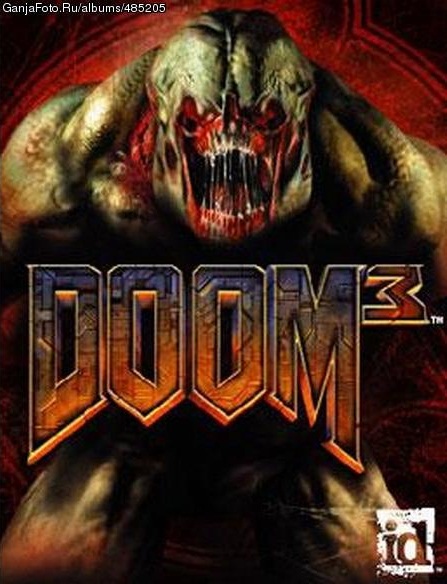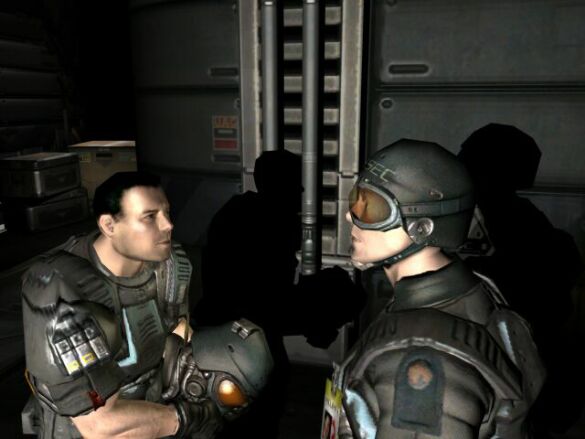Doom 3
Yes, the graphics of Doom 3 were impressive, but there is no need to talk about a major separation from the latest shooters of those years.

Doom 3 system requirements
Official:
English version of Microsoft Windows 2000/XP;
Pentium 4 1.5 GHz or Athlon XP 1500+;
384 MB RAM;
8-speed CD-ROM;
2.2 GB of free hard disk space;
100% DirectX 9.0b compatible sound card with latest drivers
100% Windows 2000/XP compatible keyboard and mouse;
installed on a DirectX 9.0b system;
3D accelerator (Radeon 8500 - GeForce 5800).
Doom III, despite the number 3 in its name, will not be a continuation of Doom 2. This is a remake of the first Doom, made using the latest graphics technology. Id Software is traditionally famous for its graphics engines. The Doom 3 engine is their latest development. The first thing that catches your eye is working with shadows. Firstly, shadows are cast by almost all objects, and secondly, depending on the light levels, the shadows can be of different intensity.
The downside of the id Tech 4 engine was that it needed a high performance graphics accelerator (like the GeForce FX or Radeon 9700) that was at least Direct3D 8 compatible and also had fully programmable pixel and vertex (vertex) shaders. By E3 2002, the recommended GPU was the Radeon 9700 with 128 MB VRAM; while the features of Direct3D 9 were not used by the engine, the efficiency, advanced architecture, and 256-bit bus of the Radeon 9700 graphics card were necessary to play Doom 3 at high graphics settings and at playable frame rates.
The release of id Tech 4 led to the obsolescence of graphics chips of the GeForce 2 class, Radeon 7200 and earlier (RIVA TNT2 and Rage 128), as the engine needed support for Direct3D 8, which was absent in these chips. Also, the engine did not support software rendering, which was provided by the Intel GMA series of integrated graphics cards. Back then, before id Tech 4, a strong CPU could make up for a weak graphics card. Before the release of Doom 3, John Carmack warned gamers not to buy GeForce 4 MX graphics cards to play the game, as these cards support Direct3D 7, but not Direct3D 8. However, many inexperienced consumers mistakenly bought the GeForce 4 MX (which does not support Direct3D 8) , confusing them with the GeForce 4 Ti (supporting Direct3D 8).
However, there have been cases where enthusiasts have managed to run Doom 3 on non-supporting graphics cards such as the Voodoo 2, however these cards were unable to render per pixel lighting and bump mapping.
Characteristics and features of the graphics engine
id Tech 4 adds a lot of new features not found in the id Tech 3 engine that preceded it. These included bump mapping using normal mapping and specular highlighting.
The main innovation of the id Tech 4 engine was the use of fully dynamic per-pixel lighting in it. Until that time, all previous 3D engines were based primarily on pre-calculated lighting or lightmaps, and although dynamic effects were available before, the effect simply changed the brightness of the entire object. The approach used in Doom 3 featured more realistic lighting and shadows than previous PC games.
Unified Lighting and Shading
In the Doom 3 screenshot, you can see the shadow on the face and body of a zombie, which was created using the Unified Lighting and Shading technology.
Unified Lighting and Shading is a light propagation model developed in 2004 by id Software and incorporated into the id Tech 4 game engine.
Previous 3D games such as Quake III Arena have used separate lighting models to determine how light illuminates player characters and environments. Lighting and shading information for game levels and maps was static, pre-generated and pre-saved, while the same information for game characters was calculated in real time (on the fly).
Doom 3, the first game powered by id Tech 4, uses a unified model that generates lighting and shading on the fly. This means that any light sources affect the entire scene, not just a predetermined part of it. The possibilities of this technology include the possibility of self-shadowing, which is implemented using shadow volumes. Using shadow volumes, characters can cast shadows on themselves: for example, a person's chin can cast a shadow on their chest.
Technology "Megatexture"
The original version of id Tech 4 was criticized for its inability to handle large open spaces. MegaTexture technology circumvents this problem by allowing the creation of extensive outdoor scenes. The desired effects and capabilities can be achieved by drawing a single massive texture (32.768 x 32.768 pixels) covering the entire polygon map and highly detailed terrain. A megatexture can also store physical information about the terrain such as gravity in certain areas, or specify what sound effect should be played if the player moves across certain parts of the map, i.e. walking on rock will seem different from walking on grass. It is expected that the use of megatexture will result in a much more detailed scene than most existing technologies, using the so-called "tile" (English tile) structures, and will also add a tool for creating a landscape, the so-called. Megagen. To date, only one game uses Megatexture technology - Enemy Territory: Quake Wars.

The game was able to literally put all the top computers of that time in a "puddle".
.




